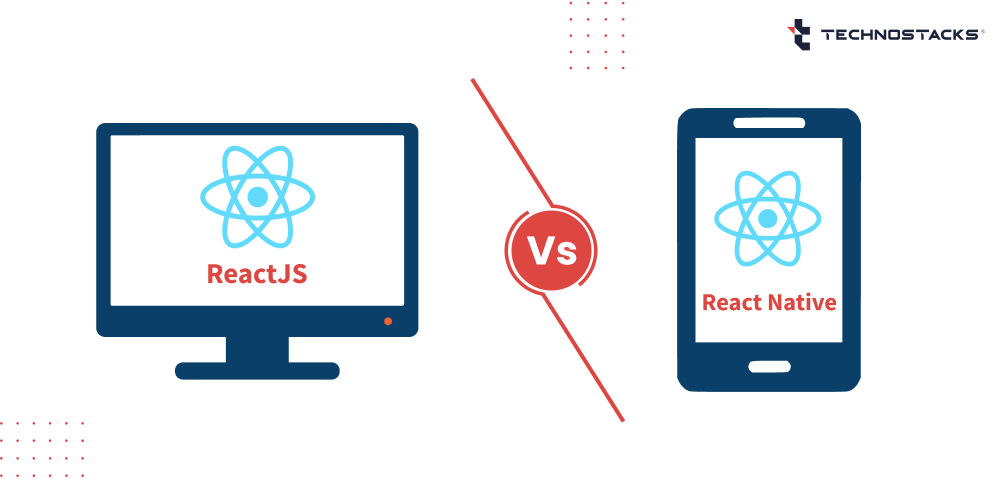What is the Difference Between React and React Native?
React vs React Native is one of the most searched query from the newbie developers. When a non-programmer hears the terms React and React Native, people frequently think that React Native is a development of React technology.
If they are starting, developers could even consider the same thing. In this article, we will be providing you with a comprehensive view of React and React native.
Overview of React vs. React Native
ReactJS and React Native are Facebook native technologies that give online and mobile app development unrivaled capabilities.
The two are different from one another in terms of functioning and important goals. Today’s most well-known websites demonstrate the differences between React Native and ReactJS.
Numerous well-liked websites and mobile applications are built around these two powerful technologies.
ReactJS development and React Native development comparison discussions are frequent in the app development community.
Even seasoned programmers, meanwhile, occasionally struggle to grasp the subtleties of the React vs. React Native debate.
Comparison of React and React Native
Before dig into the detailed article, Let’s review the quick comparison of React and React Native:
| React | React Native |
|---|---|
| 1. It is an open-source library utilized to make UI for web apps. | 1. It Is an open-source framework that makes cross-platform mobile applications on different operating systems. |
| 2. It does not depend on a specific platform and can be used across all platforms. | 2. It is dependent on the kinds of platforms being used. |
| 3. React utilizes components and HTML documentation. | 3. It does not require any HTML tags. |
| 4. The navigation system is empowered by React and has an integration with JavaScript. | 4. The interface is complicated, and navigating mobile apps is also different. |
What is React?
React is a JavaScript-based UI development library controlled by Meta and mainly used for creating the user interfaces for a single page web applications.
It is a popular web development library that made its debut in May 2013 and is now one of the frontend libraries of web development.
Features of React
Today, React is more popular than any other front-end development library, and here are the reasons:
- Easy production of dynamic apps
Compared to JavaScript, where scripting gets quite complex very fast, React needs less coding and delivers more functionality, making it simpler to create dynamic online applications. - Virtual DOM
React leverages Virtual DOM, which speeds up the creation of web apps. Instead of updating all the components as traditional web applications do, Virtual DOM analyses the previous states of the components and updates just the things in the Real DOM that were modified. - Reusability of components
Components are the fundamental units of every React application, and a single app often comprises several different components. The application’s development time is slashed significantly because of the reusability of these components, each of which has its logic and controls. - Data flow that is unidirectional
React adheres to this. As a result, developers frequently layer child components inside parent components when creating React apps. Since data only goes in one direction, it is simpler to troubleshoot faults and pinpoint the exact location of a problem in an application at any given time. - JavaScript library
React has a modest learning curve since it mostly integrates fundamental HTML and JavaScript library ideas with useful features.
What is React Native?
React native is a Javascript based framework that offers mobile app development for both Android and iOS. Although it is built on React, Facebook’s JavaScript toolkit for creating user interfaces, it targets mobile platforms instead of browsers.
In other words, using the familiar and beloved JavaScript framework, web developers can now create mobile applications that look and feel “native.”
React native makes it simple to simultaneously build for Android and iOS because most of the code you create can be shared between platforms.
Read More: Best React Component Libraries for Developers
Features of React Native
- Writing once and multiple usages
Code created with React Native runs on practically all mobile platforms, which is by far the finest feature and the true notion on which it is founded. These include Windows, Android, and iOS.
Developing Swift, Java, or C# code for iOS, Android, or Windows is unnecessary. The native nature of React native applications allows them to run across several platforms. - Programming Language
One crucial component of a framework that has a significant impact on the developers is its programming language.
A developer’s decision is always influenced if a framework utilizes a well-liked and widely-used programming language.
JavaScript is one such language used by React Native. JavaScript is undoubtedly one of the most well-liked and often used programming languages.
It is one of the World Wide Web’s (WWW) three essential technologies, along with HTML and CSS. Anyone who has even a little web programming expertise is familiar with how to utilize JavaScript. Popular web frameworks are also constructed using JavaScript. A programming language may also be learned quickly. - Community of React Native
React native is one of the strongest cross-platform mobile application development communities. Facebook began its React.js development in 2013, and it was released in 2015.
It was soon open-sourced, and its popularity grew quickly. React Native Developers from all over the world contributed, which increased its popularity and created a vibrant community for React.Js applications. - Cross-platform applications
React Native is one of the most dependable framework for creating cross-platform applications. It was created by an IT behemoth like Facebook and has been around long enough to be trusted. All of Facebook’s mobile applications utilize React Native. This justifies having faith in React Native. It is also useful for many other businesses, including Instagram, Airbnb, Skype, Tesla, Walmart, and Discord.
React vs React Native – Real World Examples
React
There are a lot of internet giants who use React for their functioning. Here are some of the examples of those businesses that use React:
- Facebook
Facebook is using ReactJS, although in a partial manner. React, software integrated into the application code, is used to build their website.React native, an analogous variation of React that displays iOS and Android components contrary to DOM elements was also used to build the mobile app.
One interesting fact is that Facebook was the first platform where the ReactJS framework was first developed. This is the reason Facebook uses the ReactJS framework in its application. React Fiber, which Facebook rewrote, is presently available in beta.
- Instagram
ReactJS has been quite useful for Instagram. Multiple features, such as Google Maps, geolocations, APIs, search engine accuracy, and tags that appear without hashtags are evidence of the use of ReactJS.It’s impressive that it’s all included in the app’s API. Instagram has allowed users to acclimate to its amazing features fully and is entirely based on the ReactJS library.
- Netflix
The React version is also compatible with Netflix, particularly on their Gibbon platform, which replaces the DOM used by web browsers in low-performance TV sets. Even Netflix has written a blog article demonstrating how the ReactJS framework improves startup time, runtime efficiency, modularity, and other benefits.
React Native
Just like React, React Native also has a lot of real-world applications. Here are some of the practical instances of businesses using React Native:
- Facebook
React Native began as a hackathon project created by Facebook in response to business requirements.Facebook sought to extend to mobile all the advantages of online development, including quick iterations and having a single team design the whole product.
React native was created and made use of in the creation of mobile apps for both iOS and Android.
- Skype
Skype announced at the start of 2017 that it was developing a new app written in React Native.All users could benefit from the information, as the app, while generally well-designed, had encountered several problems.
The full new version was redone, including the interface, icons, and a few useful new features.
It’s also important to note that Microsoft chose React Native for app development of both the Windows desktop app and the mobile platforms.
- Tesla
The renowned electric vehicle manufacturer Tesla has joined the React Native community.The business used Facebook’s trending structure to create its app for owners of electric vehicles and Powerwall batteries.
The program may be used with a smartphone to find, identify, and partially operate a car.
Tesla hasn’t provided many specifics about the initiative, but consumers have generally given the app favorable reviews.
Read More:- Top React Chart Libraries For Your Web Projects
React vs React Native – Advantages
React
- Intuitive
ReactJS offers interaction to any UI layout and is incredibly simple. Additionally, it enables the rapid and quality-assured creation of applications, saving time for both clients and developers. - Declarative
ReactJS enables large data updates that cause the user interface’s chosen portions to adapt automatically. Because of its advanced feature, you don’t need additional tasks to update your user interface. - Provides reusable components
ReactJS applications offer reusable components that programmers are free to utilize to build new applications.For React developers, the reusability functions act exactly like a cure to a grave illness. This platform allows the developers to repurpose parts created for one application for use in another with similar functionality.
- Library for JavaScript
The usage of a robust JavaScript and HTML grammar blend streamlines the entire process of developing code for the intended project.The JS library has several functions, one translating the HTML elements into necessary functions and simplifying the overall project.
- Support for components
ReactJS is the ideal fusion of HTML elements and JavaScript.Utilizing JS codes and HTML elements makes managing a sizable collection of data containing the document object model effortless.
ReactJS serves as a mediator during this period, acting as the DOM’s representative and helping to determine which component changes are necessary to obtain the desired effects.
- SEO-friendly
After extensive research and the development by Facebook, React JS came into. It stands out from the competition and enables designers to create outstanding, search engine optimized user experiences for all browsers and engines. - Successful data binding
One-way data binding is behind ReactJS. This indicates that anyone who makes every modification to any specific data segment is traceable. This represents how straightforward ReactJS is.
React Native
- Community-driven nature
React native initially came into being during a hackathon in 2013 in response to a need from the developer community. They were searching for a mobile alternative that would combine the benefits of developing mobile apps with the strength and flexibility of the native React environment.React native, a framework developed by Facebook and backed and continually advanced by the development community, is the consequence of this.
Utilizing such a community-driven ecosystem has several benefits, including the availability of a sizable team of passionate native and JS developers ready to contribute their knowledge and skills, as well as enormous catalogs of publicly accessible components.
- Utmost reusability of code and cost-effectiveness
You may simultaneously release the same code to iOS and Android by utilizing React Native. This results in high cost and time savings for development efforts. The development work theoretically is reduced in half.The cost savings will be a bit less significant, but they will still be more compelling enough to warrant the expenditure.
Recent calculations show that 90% of the code reusability between Android and iOS, but it would be fair to factor in some extra time for useful updates.
- Live Reload
React native, which expands on React’s concepts and enables you to develop potent mobile apps, may be thought of as the mobile equivalent of React.React native has a useful bonus that you won’t find in native frameworks: the “live reload” function lets you view the outcome of the most recent modification you’ve made to the code immediately.
You can immediately observe the impact of changes made to one screen on the other if you have two windows open—one holding the code and the other displaying a mobile screen resulting from the code.
- Effective Performance
The architecture of React Native has been specifically designed for mobile platforms.While native platforms are more “CPU (Central Processing Unit) heavy,” it uses the GPU (Graphics Processing Unit) effectively.
React native is far faster than hybrid solutions, formerly the only cross-platform choice. - Architecture similar to react
The same benefit of adopting React that was earlier discussed can be emphasized here: the modular architecture and user-friendly interface make it extremely simple for other developers to dive into and build upon the work of others.This boosts a development team’s flexibility and makes building updates and upgrades for web apps simpler.
Additionally, it will take testers less time to comprehend the logic of the code and create suitable testing scenarios.
Anyone, a client or a CFO, wants to hear that they will save money and important time. This benefit is particularly transferred from the web to mobile devices and vice versa.
Read More:- React Best Practices Every Developer Have to Follow
React vs React Native – Disadvantages
React
- The fast pace of development
The rapid speed of development has benefits and drawbacks. In the event of a drawback, some developers may not feel comfortable routinely relearning the new methods of doing things due to the environment changing so quickly.As the technology is improving, daily ongoing upgrades could be thought-provoking for the developers to adapt to all these changes. They must constantly refresh their knowledge and pick up new techniques.
- Poor documentation
Poor documentation is another drawback of continually evolving technology.React technologies are evolving and speeding up so quickly that there is no timely creation of suitable documentation.
To get around this, developers create instructions when new tools and versions are included in their ongoing projects.
- View part
Only the UI Layers of the application are covered by ReactJS. You must still select a few other technologies to acquire a consolidated toolkit for project development. - Barrier created by JSX
JSX is used by React JS and is a syntactic extension that permits mixing HTML and JavaScript.Although this method has its own advantages, some development community members see JSX as a barrier, particularly for beginning developers.
The learning curve’s difficulty is a source of complaints from developers.
React Native
- Lower performance rate
React Native cannot utilize all of a given platform’s advantages and possibilities. A native app, on the other hand, may increase functionality and produce the best user experience. - Inefficient design
Consider native development if intricate designs or sophisticated interactions are a key component of your competitive edge. React native might not be suitable to fulfill this purpose. - Custom modules
Although many custom modules are accessible, you could require certain particular parts you will have to create yourself from the start. - Updating issues
Updating the program to the newest React Native version is challenging. Most of the time, updating React Native versions is a complex procedure.
Read More:- How to Improve the Performance of React Native App?
When to use React?
You should use React in front end development of a user interface that requires a lot of user interaction.
Those interactive components are difficult to build and bind time to the underlying business logic.
You need to concentrate on the interface’s view model because React handles the lower-level algorithm.
If your current code base grows too large, you should switch to React.
You need discipline while writing thousands of lines of UI code. Otherwise, it’s just a matter of time until the codebase becomes too complex to do basic troubleshooting.
When to use React Native?
When it comes to using React Native, there aren’t any limitations based on the industry.
The important point is that it is a sufficient foundation for any customer-facing apps that do not substantially rely on OS-specific capabilities and integrations, such as augmented reality (AR) or virtual reality (VR), or that do not require elaborate design or animations to build competitive advantage.
React Native speeds up the development process and provides enough tools and modules to create a reliable application.
Another benefit is that creating a React Native mobile app is simpler when your online app is written in React.
When not to use React?
There are two situations where you do not need to use React:
First, If the needs are overly straightforward, using React can be excessive. You may need to create a few pages, for instance, without any dynamic features or customization.
In these circumstances, some basic HTML and JavaScript may be sufficient. You’ll save money, staff time, and time overall.
Expert Pro Tip: It is best to utilize ReactJS from the start if you intend to add additional interactive features to the landing page later.
Second, ReactJS is not a wise choice for complex admin panels, either. If you stay with backend frameworks, in this case, your life will be considerably simpler. ReactJS requires more code to create common admin panel items than backend frameworks.
Read More:- Reasons Why React Native Is Called As The Future Of Hybrid Apps
When not to use React Native?
Here are the two situations where you do not need to use React Native:
First, consider this situation where you are creating a chat application. High levels of customization are necessary for the software, and several processes are active at any moment. It’s unlikely that any developer would choose React Native if you asked them about the framework they want to use to create this app.
Second, It is far simpler to utilize native app development than React Native when you want to construct utilities like battery monitoring, media players, antivirus software, etc. This is because these applications always use native iOS capabilities and APIs.
Key Takeaways
Now that you have a technical overview of React vs React Native, you can decide based on your needs and preferences.
Technostacks is a globally renoved mobile app development company and have a team of experienced developers.
If you have an idea for app development or web development, don’t hesitate to contact us.
If you have any specific questions, then comment below.
Frequently Asked Questions for React vs React Native
- Which is better? React or React Native?
ReactJS is the greatest choice when creating high-performing, dynamic, and responsive user interfaces for web interfaces.React native is the best choice for giving mobile apps a fully native experience.
- What is the main difference between React and React native?
React is a JavaScript library of reusable components made to construct app frameworks, whereas React Native is set up to make native mobile apps using reusable components. - Are React and React Native the Same?
Like React, React native employs native components as its building blocks rather than web components. Instead of the browser, it is directed at mobile platforms. - Which is easy to learn: React or React native?
If you have experience with web programming, React native is incredibly simple to understand. Any platform that supports React Native may be targeted by a developer that is proficient in React. The foundational web technologies necessary to master React are HTML, CSS, and JavaScript. - Should I learn React or React native?
The ideas you will work on when building react native depend on React itself; thus, it is best to grasp react before working with react native. - Why use React Native instead of React?
You should use React Native for creating a mobile applications. Whereas React is used for the web applications.Creating cross-platform apps is React Native’s main advantage for developers. Thanks to code reuse, one codebase may be used to deploy on both the Android and iOS platforms.
- Is React Native Frontend or Backend?
The way frontend web software is developed changed as a result of React. It combines a Javascript library, front-end development library and component-based architecture to perform the functions of HTML markup, CSS stylesheets, and standard JS all at once. - Is React Native Difficult to learn?
For someone coming from a web programming experience, learning React Native is relatively simple.Any platform that React Native supports may be targeted by a developer familiar with React. The fundamental web technologies that must be learned to use React are HTML, CSS, and JavaScript.
- Why React Native is Used?
These days, many businesses prefer React Native to build their apps since it enables them to launch their apps across both platforms with only one piece of code. Additionally, it eliminates the need for two separate development teams to be hired and paid to maintain two different code bases.








